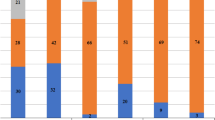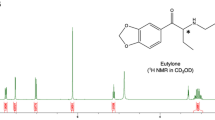Abstract
Fluoride is a common stabilizing agent in forensic toxicology to avoid the frequent problem of degradation of drugs in blood samples especially described for cocaine. In cases only samples with addition of fluoride are available, it is a crucial question if also concentrations of common drugs other than cocaine (amphetamines, opiates and cannabinoids) are affected by fluoride. So far, there are only rare literature data available on discrepant results especially for Δ9-tetrahydrocannabinol (THC). In this study, comparative analysis of positive tested paired routine plasma/serum samples (n = 375), collected at the same time point (one device with and one without fluoride), was carried out with special focus on cannabinoids. Samples were measured with validated routine liquid chromatography-tandem mass spectrometry methods for THC, 11-hydroxy-THC (THC-OH), 11-nor-9-carboxy-THC (THC-COOH), cocaine, benzoylecgonine, ecgonine methyl ester, morphine, codeine, amphetamine, methamphetamine, 3,4-methylenedioxymethamphetamine, 3,4-methylenedioxyamphetamine, and 3,4-methylenedioxyethylamphetamine, and results were statistically evaluated. Beside the expected stabilization effect on cocaine and the consequently reduced concentration of ecgonine methyl ester in fluoride samples, benzoylecgonine was elevated compared to respective samples without fluoride. Most importantly, new findings were significantly reduced mean concentrations of THC (− 17%), THC-OH (− 17%), and THC-COOH (− 22%) in fluoride samples. Mean amphetamine concentration was significantly higher in samples with the additive (+ 6%). For the other amphetamine type of drugs as well as for morphine and codeine, no significant differences could be seen. Whenever specified thresholds have been set, such as in most European countries, the use of different blood sample systems may result in a motorist being differently charged or prosecuted. The findings will support forensic toxicologists at the interpretation of results derived from fluoride-stabilized blood samples.


Similar content being viewed by others
References
Stewart DJ, Inaba T, Tang BK, Kalow W (1977) Hydrolysis of cocaine in human plasma by cholinesterase. Life Sci 20:1557–1563
Isenschmid DS, Levine BS, Caplan YH (1989) A comprehensive study of the stability of cocaine and its metabolites. J Anal Toxicol 13:250–256
Toennes SW, Kauert GF (2001) Importance of vacutainer selection in forensic toxicological analysis of drugs of abuse. J Anal Toxicol 25:339–343
Cone EJ, Hillsgrove M, Darwin WD (1994) Simultaneous measurement of cocaine, cocaethylene, their metabolites, and “crack” pyrolysis products by gas chromatography-mass spectrometry. Clin Chem 40:1299–1305
Brogan WC, Kemp PM, Bost RO, Glamann DB, Lange RA, Hillis LD (1992) Collection and handling of clinical blood samples to assure the accurate measurement of cocaine concentration. J Anal Toxicol 16:152–154
Baselt RC (1983) Stability of cocaine in biological fluids. J Chromatogr 268:502–505
Paul LD, Musshoff F (2009) (Anhang A) Qualitätsanforderungen an die Bestimmung spezieller Analyten aus biologischen Matrices mit Tabellenanhang (aktuelle Vorgaben zu Bestimmungsgrenzen). Toxichem Krimtech 76:177–184
Giorgi SN, Meeker JE (1995) A 5-year stability study of common illicit drugs in blood. J Anal Toxicol 19:392–398
McCurd HH, Callahan LS, Williams RD (1989) Studies on the stability and detection of cocaine, benzoylecgonine, and 11-nor-delta-9-tetrahydrocannabinol-9-carboxylic acid in whole blood using abuscreen® radioimmunoassay. J Forensic Sci 34:858–870
Sørensen LK, Hasselstrøm JB (2013) Stability of drugs in whole blood—from sampling to testing (poster). TIAFT—51th Annual Meeting—September 2–6, 2013—Funchal, Madeira—Portugal
Toennes SW (2013) Möglichkeiten und Grenzen der Interpretation von Cannabinoid-Blutkonzentrationen (technical lecture). In: Püschel K, Dittmann V, Schubert W (ed.) Fahrunsicherheit, Unfallvermeidung, Unfallrekonstruktion, Rehabilitation Fahreignung - 8. Gemeinsames Symposium der DGVM und DGVP am 7. und 8. September 2012 in Hamburg. Kirschbaum Verlag, Bonn, 76-78
Wong K, Brady JE, Li G (2014) Establishing legal limits for driving under the influence of marijuana. Inj Epidemiol 1(1):26
Peters FT, Drummer OH, Musshoff F (2007) Validation of new methods. Forensic Sci Int 165(2–3):216–224
Bland JM, Altman DG (2003) Applying the right statistics: analyses of measurement studies. Ultrasound Obstet Gynecol 22:85–93
Roth N, Kneisel S, Auwärter V (2011) Stabilität von Cannabinoiden in Serumproben nach mehreren Einfrier- Auftauzyklen und Lagerung in Glas- bzw. Kunststoffröhrchen. Toxichem Krimtech 78:36–44
Schwilke EW, Karschner EL, Lowe RH, Gordon AM, Cadet JL, Herning RI, Huestis MA (2009) Intra- and intersubject whole blood/plasma cannabinoid ratios determined by 2-dimensional, electron impact GC-MS with cryofocusing. Clin Chem 55:1188–1195
Giroud C, Menetrey A, Augsburger M, Buclin T, Sanchez-Mazas P, Mangin P (2001) Delta(9)-THC, 11-OH-delta(9)-THC and delta(9)-THCCOOH plasma or serum to whole blood concentrations distribution ratios in blood samples taken from living and dead people. Forensic Sci Int 123:159–164
Jantos R, Schuhmacher M, Veldstra JL, Bosker WM, Klöpping-Ketelaars I, Touliou K, Sardi GM, Brookhuis KA, Ramaekers JG, Mattern R, Skopp G (2011) Determination of blood/serum ratios of different forensically relevant analytes in authentic samples. Arch Kriminol 227:188–203
Baselt RC (2014) Disposition of toxic drugs and chemicals in man, 10th edition. Biomedical Publications, Seal Beach, CA, pp. 122, 516, 1315 and 1318
Skopp G, Pötsch L, Ganssmann B, Aderjan R, Mattern R (1998) A preliminary study on the distribution of morphine and its glucuronides in the subcompartments of blood. J Anal Toxicol 22:261–264
Author information
Authors and Affiliations
Corresponding author
Ethics declarations
Conflicts of interest
The authors declare that they have no conflict of interest.
Rights and permissions
About this article
Cite this article
Wiedfeld, C., Krueger, J., Skopp, G. et al. Comparison of concentrations of drugs between blood samples with and without fluoride additive—important findings for Δ9-tetrahydrocannabinol and amphetamine. Int J Legal Med 133, 109–116 (2019). https://doi.org/10.1007/s00414-018-1797-5
Received:
Accepted:
Published:
Issue Date:
DOI: https://doi.org/10.1007/s00414-018-1797-5




